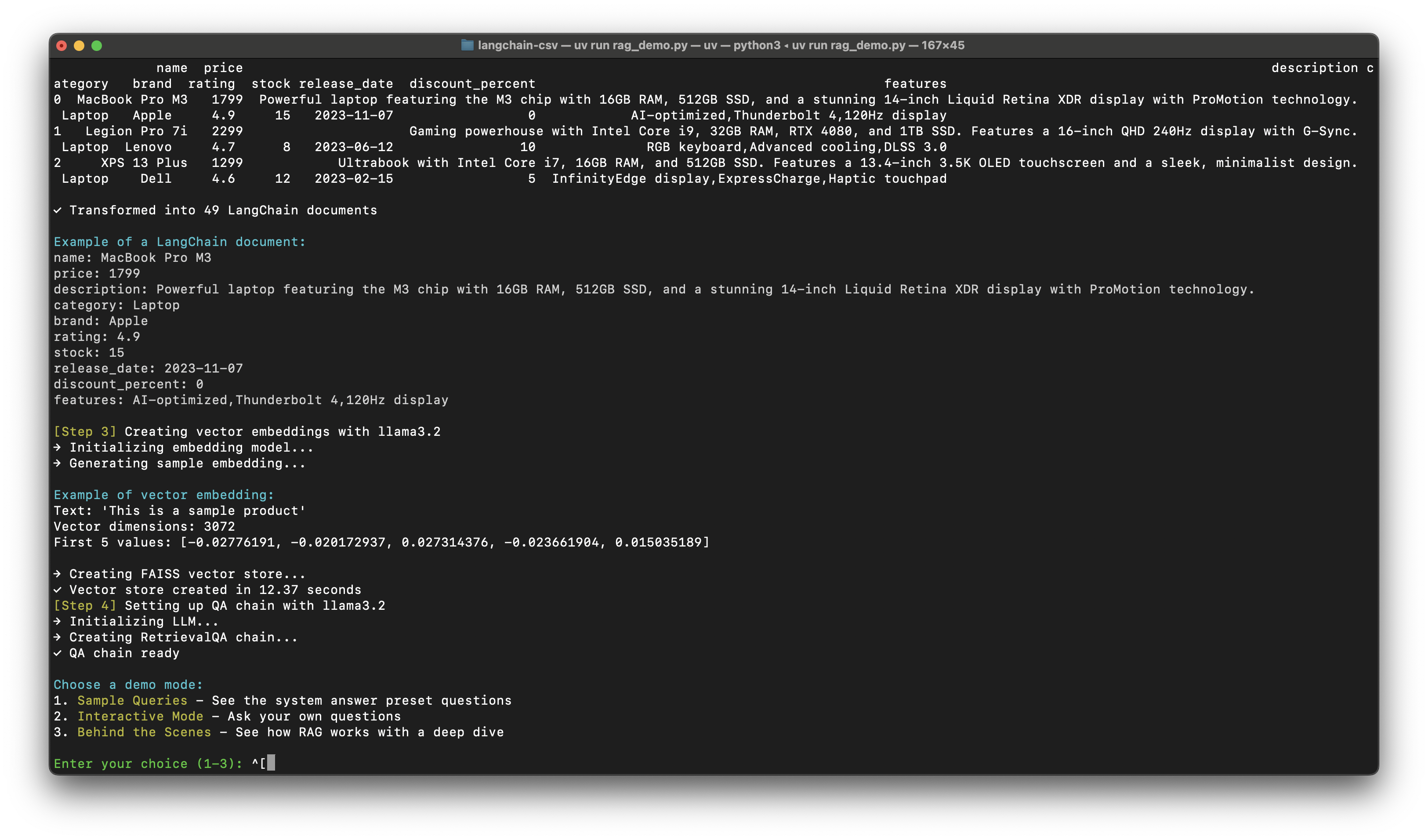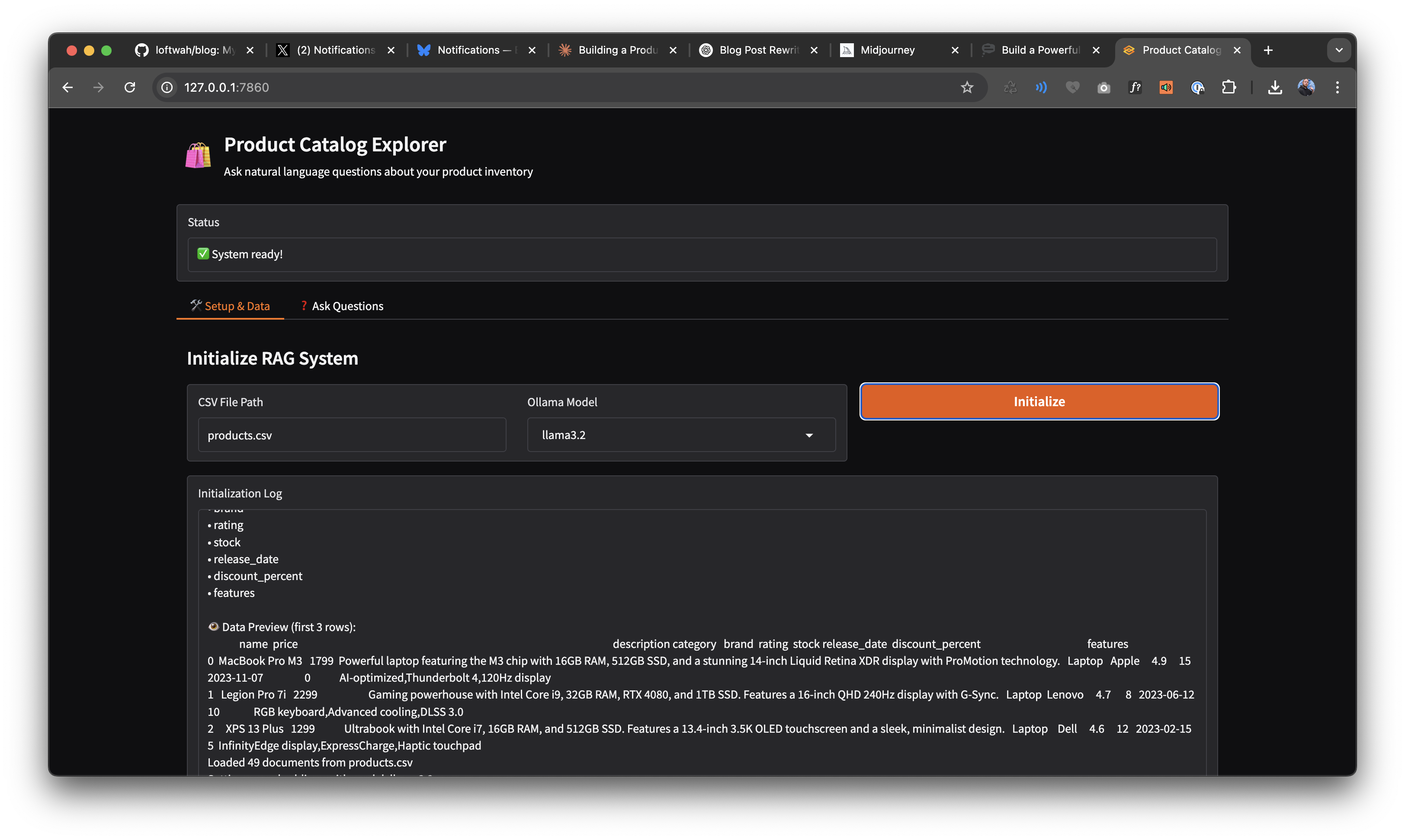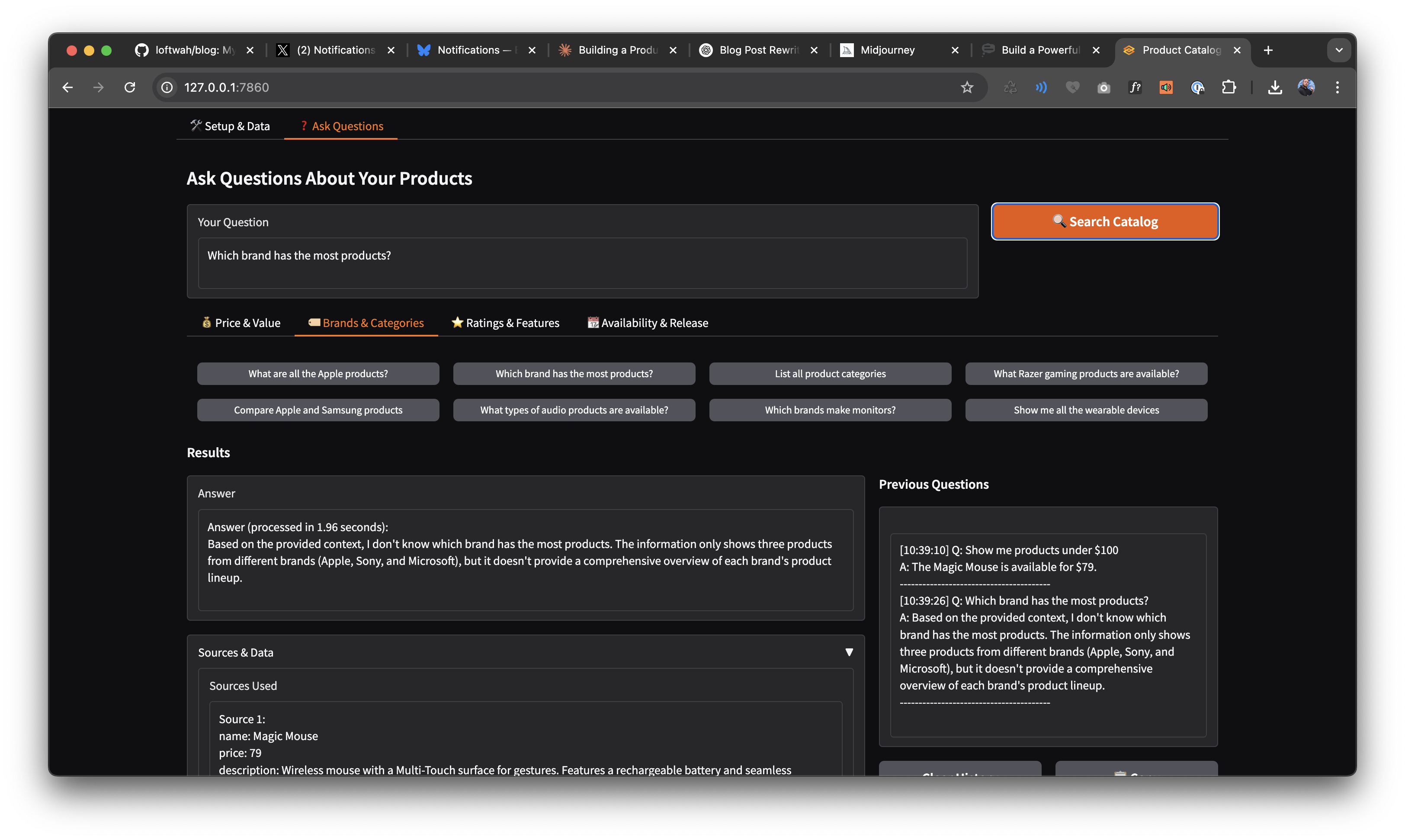

Build a Powerful Product Catalog Explorer with LangChain, Ollama, and Gradio
In this article, I’ll guide you through creating an interactive Product Catalog Explorer using Python, LangChain, Ollama, and Gradio. This system leverages a hybrid approach called Retrieval-Augmented Generation (RAG), combining vector search capabilities with direct data analysis to answer questions about products naturally and accurately.
Imagine easily answering queries such as:
- “What’s the cheapest laptop available?”
- “List highly-rated products currently on sale.”
Let’s explore how this is done step-by-step.
Project Overview
The langchain-csv project provides two intuitive interfaces:
- Gradio Web Interface: An easy-to-use, interactive web app.
- Command-Line Interface (CLI): A colourful terminal application.
Both interfaces share a Retrieval-Augmented Generation (RAG) backend, enhanced by direct data analysis for handling precise numerical and comparative queries effectively.
 The command-line RAG demo interface showing direct data analysis output
The command-line RAG demo interface showing direct data analysis output
Technologies Used
Our tech stack includes:
- Python: Core language for developing the project.
- uv: A modern package manager for Python environments.
- LangChain: Framework for building RAG pipelines.
- Ollama: Facilitates running local LLMs.
- FAISS: Provides efficient vector similarity searches.
- Pandas: Enables robust data manipulation and analysis.
- Gradio: Powers the interactive web interface.
- Colorama: Adds color-coded outputs in terminal interfaces.
Quick Setup
Follow these steps to get the system running:
# Clone the repository
git clone https://github.com/loftwah/langchain-csv.git
cd langchain-csv
# Set up dependencies
uv venv
uv pip install langchain langchain_community langchain_ollama faiss-cpu colorama gradio pandas
# Ensure Ollama is running and pull required models
ollama pull llama3.2
# Launch the Gradio web interface
uv run gradio_demo.pyYou can also explore the command-line demo for a different interactive experience:
uv run rag_demo.pyData: The Product Catalog
Our explorer uses product data from a CSV file. The sample products.csv includes:
- Basic Information: Name, price, description, category, brand, and rating.
- Extended Data: Stock availability, release dates, discounts, and product features.
This detailed dataset enables comprehensive queries ranging from basic product lookups to advanced analytics.
 The Gradio interface setup tab showing the product data preview
The Gradio interface setup tab showing the product data preview
How the RAG System Operates
Here’s a step-by-step breakdown of the Retrieval-Augmented Generation (RAG) system:
1. Loading CSV Data with LangChain
Each CSV row is converted into a LangChain-compatible document:
def load_csv_data(csv_file):
from langchain_community.document_loaders import CSVLoader
loader = CSVLoader(csv_file)
documents = loader.load()
return documents2. Generating Vector Embeddings
Use Ollama to create semantic embeddings from product descriptions, enabling efficient queries:
from langchain_ollama import OllamaEmbeddings
def create_embeddings(documents, model="llama3.2"):
embeddings = OllamaEmbeddings(model=model)
vector_store = FAISS.from_documents(documents, embeddings)
return vector_store3. Implementing the QA Chain
LangChain creates a retrieval-based QA chain:
from langchain.chains import RetrievalQA
def setup_qa_chain(vector_store, model="llama3.2"):
retriever = vector_store.as_retriever()
qa_chain = RetrievalQA.from_chain_type(
retriever=retriever,
chain_type="stuff",
llm=OllamaLLM(model=model),
return_source_documents=True
)
return qa_chain4. Hybrid Query Processing: Direct Data Analysis
For precise or numeric queries, direct analysis with Pandas ensures accuracy:
def direct_data_analysis(query, df):
query_lower = query.lower()
if "cheapest" in query_lower:
product = df.loc[df['price'].idxmin()]
return f"The cheapest product is {product['name']} at ${product['price']}."
# Additional specific handlers for price, stock, or other metrics...
return NoneThis combination of semantic search and direct analysis provides fast and accurate answers.
User Interfaces
Gradio Web Interface
The Gradio interface offers an intuitive, web-based experience:
import gradio as gr
with gr.Interface(
fn=process_query,
inputs="text",
outputs="text",
title="Product Catalog Explorer",
description="Ask questions about our product catalog in natural language!"
) as demo:
demo.launch() The Gradio interface query tab showing sample questions and results
The Gradio interface query tab showing sample questions and results
CLI Interface with Colorama
For command-line enthusiasts, we’ve added a colorful interactive CLI:
from colorama import Fore, Style
print(Fore.GREEN + "Welcome to Product Explorer!" + Style.RESET_ALL)
# Interactive prompts and formatted responses hereWhy Use This Approach?
The strength of this system lies in its hybrid nature:
- Flexible Queries: Handles open-ended questions seamlessly.
- Precision Queries: Accurately manages numeric and comparative data.
- Efficiency: Rapid response times through vector embeddings and local models.
This method gives you the power of advanced AI-driven queries combined with traditional data precision.
Dive Deeper and Customize
Check out the full project on GitHub for a deeper dive. It’s structured to be modular, allowing you to extend and adapt it to your unique needs.
Give the repository a ⭐️ if you find it useful, and feel free to fork it, enhance it, and contribute your own improvements!
Final Thoughts
By combining LangChain, Ollama, Gradio, and Pandas, we’ve created a versatile, user-friendly system perfect for exploring product catalogs with natural language.
Whether you’re building customer-facing tools or internal analytics, this approach provides an excellent foundation to get started.
If you found this helpful, I’d appreciate a star on the GitHub repository.